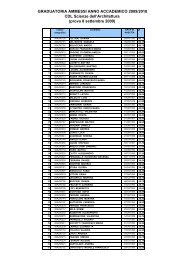Iris marsica I.Ricci & Colas. - Università degli Studi di Camerino
Iris marsica I.Ricci & Colas. - Università degli Studi di Camerino
Iris marsica I.Ricci & Colas. - Università degli Studi di Camerino
Create successful ePaper yourself
Turn your PDF publications into a flip-book with our unique Google optimized e-Paper software.
<strong>Iris</strong> <strong>marsica</strong> I.<strong>Ricci</strong> & <strong>Colas</strong>.
<strong>Università</strong> <strong>degli</strong> <strong>Stu<strong>di</strong></strong> <strong>di</strong> <strong>Camerino</strong><br />
Viale Oberdan<br />
62032 <strong>Camerino</strong> (MC) – ITALIA<br />
tel. +39 – 0737 403084<br />
fax. +39 – 0737 403085<br />
email: ortobotanico@unicam.it<br />
http://www.unicam.it/ortobotanico
Informazioni generali/general information<br />
Estensione/extension: 10.000 mq<br />
Long./long.: 13° 04’ E; Latit./latit.: 43° 08’ N<br />
Altitu<strong>di</strong>ne/elevation:636 m s.l.m.<br />
L’Orto Botanico “Carmela Cortini”<br />
dell’<strong>Università</strong> <strong>di</strong> <strong>Camerino</strong> è stato<br />
istituito nel 1828 dal prof. Vincenzo<br />
Ottaviani, docente <strong>di</strong> Botanica e<br />
Chimica nella medesima università. Si<br />
estende su una superficie <strong>di</strong> circa un<br />
ettaro ai pie<strong>di</strong> delle mura del Palazzo<br />
Ducale e si affaccia a Sud-Est verso i<br />
Monti Sibillini. Circa 950 taxa sono<br />
<strong>di</strong>stribuiti in due parti principali, una<br />
nemorale sul pen<strong>di</strong>o, <strong>di</strong> impianto<br />
ottocentesco, in cui gli alberi secolari<br />
formano un boschetto, e un'altra in<br />
piano, con specie erbacee, arbustive ed<br />
arboree <strong>di</strong> varia metratura, anche a<br />
scopo ornamentale.<br />
Nella zona pianeggiante si in<strong>di</strong>viduano<br />
<strong>di</strong>verse aree tematiche, ad esempio<br />
quella de<strong>di</strong>cata alla flora d’altitu<strong>di</strong>ne<br />
dell’Appennino centrale, la gariga, lo<br />
stagno, le specie bulbose marchigiane.<br />
Ai due lati dell’ingresso principale ci<br />
sono due serre che ospitano piante in<br />
vaso, tropicali e subtropicali, epifite e<br />
succulente, e due terrari per la<br />
coltivazione <strong>di</strong> piante carnivore e<br />
sfagno.<br />
L’Orto Botanico, oltre che attività <strong>di</strong><br />
ricerca, ha sviluppato negli ultimi anni,<br />
<strong>di</strong>versi progetti <strong>di</strong> <strong>di</strong>vulgazione<br />
scientifica.<br />
(http://www.unicam.it/ortobotanico/)<br />
The Botanical Garden “Carmela<br />
Cortini” of <strong>Camerino</strong> University was<br />
founded in 1828 by Vincenzo<br />
Ottaviani, Professor of Botany and<br />
Chemistry in the same university.<br />
It covers 2.40 acres at the bottom of the<br />
“Da Varano Ducal Palace”, and it faces<br />
N-E <strong>di</strong>rection, towards the Sibillini<br />
Mountains. 950 taxa are cultivated and<br />
<strong>di</strong>stributed in two main areas: one is<br />
located along a slope, where centuryold<br />
trees form a grove, the other one is<br />
on some flat land where herbaceous<br />
species, shrubs and trees of <strong>di</strong>fferent<br />
sizes, also for ornamental purpose,<br />
grow.<br />
On the flat area there are <strong>di</strong>fferent<br />
thematic parts, for exemple a flower<br />
bed central Apennines typical species,<br />
with typical species of the central<br />
Apennines, a garrigue, a pond, a flower<br />
bed with bulbs typical of the Marche<br />
region. Tropical and subtropical plants,<br />
epiphytes and succulents are grown in<br />
two greenhouses on the sides of the<br />
main entrance, where two terrariums<br />
with carnivorous plants and Sphagnum<br />
are also located.<br />
In recent last years, besides scientific<br />
research, the Botanical Garden has<br />
carried out some projects of scientific<br />
interest for schools in our region.<br />
(http://www.unicam.it/ortobotanico/)<br />
Orario <strong>di</strong> apertura/opening hours: 9.00-13.00 a.m., 15.00-17.00 p.m.;<br />
sabato/saturday: 9.00-12.00 a.m.
Dati climatici / climatic data<br />
(me<strong>di</strong>e sul periodo 1961-90 / over the 1961-90 years)<br />
temperature e<br />
piovosità me<strong>di</strong>e<br />
mensili / monthly<br />
average temperature<br />
and rainfall<br />
T max (°C)<br />
gen<br />
jan<br />
feb<br />
feb<br />
mar<br />
mar<br />
apr<br />
apr<br />
mag<br />
may<br />
mesi/months<br />
giu<br />
jun<br />
lug<br />
jul<br />
ago<br />
ago<br />
set<br />
sep<br />
ott<br />
oct<br />
nov<br />
nov<br />
<strong>di</strong>c<br />
dec<br />
4,9 6,7 9,8 14,1 18,9 23,5 27,4 27,1 22,6 15,5 10,6 6<br />
T min (°C)<br />
precipitazioni<br />
-0,7 -0,2 3,7 6,9 11,1 13,8 16,1 16,2 14,4 10,1 5,7 0<br />
rainfall (mm) 87 103 100 94 68 66 46 61 55 117 119 126<br />
temperature e<br />
piovosità me<strong>di</strong>e<br />
stagionali / seasonal<br />
average temperature<br />
and rainfall<br />
T max (°C)<br />
T min (°C)<br />
inv<br />
win<br />
stagione/season<br />
pri<br />
spr<br />
est<br />
sum<br />
Direttore/<strong>di</strong>rector: Dr. Chiara Invernizzi (chiara.invernizzi@unicam.it)<br />
aut<br />
aut<br />
5,9 14,3 26 16,2<br />
-0,3 7,2 15,4 10,1<br />
precipitazioni/<br />
rainfall (mm) 316 262 173 291<br />
Curatore/curator: Dr. Roberta Tacchi (roberta.tacchi@unicam.it)<br />
Capo giar<strong>di</strong>niere/master gardener: Domenico Lucarini<br />
temperature e piovosità<br />
me<strong>di</strong>e annuali / yearly<br />
average temperature and<br />
rainfall<br />
T max (°C)<br />
Giar<strong>di</strong>nieri/gardeners and seed collectors: Massimo Fattinnanzi, Gianluca Pilli<br />
anno<br />
year<br />
15,6<br />
T min (°C)<br />
precipitazioni/<br />
8,1<br />
rainfall (mm) 1.042
Regolamento per lo scambio del<br />
materiale vivente.<br />
In seguito alla Convenzione<br />
Internazionale sulla Bio<strong>di</strong>versità (Rio<br />
de Janeiro, 1992), l’Orto Botanico <strong>di</strong><br />
<strong>Camerino</strong> fornisce semi e altro<br />
materiale vegetale in conformità con il<br />
Co<strong>di</strong>ce <strong>di</strong> Condotta per gli Orti<br />
botanici.<br />
Dal marzo del 2010 abbiamo adottato il<br />
Co<strong>di</strong>ce <strong>di</strong> Condotta definito dall’IPEN<br />
(International Plant Exchange<br />
Network)<br />
(http://www.bgci.org/resources/ipen/).<br />
I membri IPEN possono ottenere il<br />
materiale richiesto senza ulteriori<br />
accor<strong>di</strong> bilaterali, mentre per gli altri è<br />
necessaria la sottoscrizione<br />
dell’Accordo <strong>di</strong> Trasferimento del<br />
Materiale, da parte del rappresentante<br />
dell’Istituzione ricevente.<br />
Insieme ai semi o alle spore viene<br />
fornito un co<strong>di</strong>ce <strong>di</strong> tracciabilità che<br />
in<strong>di</strong>ca: il paese <strong>di</strong> origine es. “IT” o<br />
“XX” se l’origine è sconosciuta –<br />
un’eventuale limitazione per la<br />
cessione, “1” se la restrizione esiste,<br />
“0” se non esiste – l’acronimo<br />
dell’Istituzione, nel nostro caso CAME<br />
e infine un co<strong>di</strong>ce <strong>di</strong> accessione interno<br />
all’Orto Botanico (es. IT-0-CAME-<br />
2010/006).<br />
Tale co<strong>di</strong>ce dovrà seguire sempre la<br />
nuova accessione e i suoi <strong>di</strong>scendenti,<br />
in modo da poterne rintracciare<br />
l’origine in qualsiasi momento.<br />
Regulations on the exchange of living<br />
plant material.<br />
In response to the Convention on<br />
Biological Diversity (CBD), the<br />
<strong>Camerino</strong> Botanical Garden supplies<br />
seeds and other plant material only in<br />
accordance with the Code of Conduct<br />
for Botanic Gardens.<br />
In March 2010 we joined the IPEN<br />
Code of Conduct (International Plant<br />
Exchange Network)<br />
(http://www.bgci.org/resources/ipen/).<br />
IPEN membership allows exchange<br />
with other IPEN-members without bilateral<br />
agreements, but non-IPEN<br />
members need to sign the Material<br />
Transfer Agreement, by an entitled<br />
representant of the receiving<br />
institution.<br />
Seeds and spores are provided with an<br />
IPEN number that consist of: Country<br />
of origin e.g. “IT” or “XX” for unknow<br />
origin - Restriction of transfer, “1” if<br />
there exist a restriction, “0” if none –<br />
Institution acronym, in our case<br />
CAME and at least our accession<br />
number (e.g. IT-CAME 2010/006).<br />
The IPEN number as a whole must<br />
always stay attached to the accession<br />
and its descendants so that the origin of<br />
the material can always be traced back.
Pteridophyta<br />
Aspleniaceae<br />
1. Asplenium ceterach L. subsp. ceterach IT-0-CAME-2012/002<br />
2. Asplenium onopteris L. IT-0-CAME-2012/003<br />
3. Asplenium scolopendrium L. subsp. scolopendrium IT-0-CAME 2012/004<br />
4. Asplenium trichomanes L. subsp. quadrivalens D.E. Mey.<br />
Dryopteridaceae<br />
IT-0-CAME-2012/197<br />
5. Dryopteris filix-mas (L.) Schott IT-0-CAME 2012/005<br />
6. Polystichum setiferum (Forssk.) Moore ex Woyn.<br />
Polypo<strong>di</strong>aceae<br />
IT-0-CAME-2012/006<br />
7. Platycerium bifurcatum (Cav.) C. Chr. var. bifurcatum XX-0-CAME-2012/001<br />
8. Polypo<strong>di</strong>um interjectum Shivas<br />
Pteridaceae<br />
IT-0-CAME-2012/007<br />
9. A<strong>di</strong>antus capillus-veneris L. IT-0-CAME-2012/198<br />
Gymnospermae<br />
Cupressaceae<br />
10. Juniperus communis L. subsp. communis IT-0-CAME 2012/008<br />
11. Juniperus oxycedrus L. subsp. deltoides (R.P. Adams) N.G. Passal. IT-0-CAME 2012/009<br />
Pinaceae<br />
12. Cedrus atlantica (Endl.) G. Manetti ex Carrière XX-0-CAME 2012/010<br />
Angiospermae<br />
Monocotyledones<br />
Amaryllidaceae<br />
13. Allium ampeloprasum L. XX-0-CAME 2010/011<br />
14. Allium angulosum L. IT-0-CAME 2011/133<br />
15. Allium cepa L. XX-0-CAME 2011/134<br />
16. Allium neapolitanum Cirillo IT-0-CAME-2012/199<br />
17. Allium nigrum L. IT-0-CAME 2012/012<br />
18. Allium roseum L. XX-0-CAME 2012/135<br />
19. Allium schoenoprasum L. XX-0-CAME-2012/200<br />
20. Leucojum aestivum L. subsp. aestivum XX-0-CAME-2012/201<br />
21. Nothoscordum gracile (Aiton) Stearn<br />
Araceae<br />
XX-0-CAME 2012/014<br />
22. Dracunculus vulgaris Schott IT-0-CAME 2011/144
Asparagaceae<br />
23. Bellevalia dubia (Guss.) Kunth IT-0-CAME 2012/015<br />
24. Bellevalia romana (L.) Rchb. IT-0-CAME 2011/017<br />
25. Oncostema peruviana ( L.) Speta<br />
Cyperaceae<br />
XX-0-CAME 2011/018<br />
26. Carex depauperata Curtis ex Stokes IT-0-CAME-2012/016<br />
27. Carex pendula Huds. IT-0-CAME 2012/136<br />
28. Carex sylvatica Huds. subsp. sylvatica<br />
Dioscoreaceae<br />
IT-0-CAME 2012/202<br />
29. Dioscorea communis (L.) Cad<strong>di</strong>ck & Wilkin<br />
Iridaceae<br />
IT-0-CAME 2012/062<br />
30. Gla<strong>di</strong>olus illyricus W.D.J. Koch IT-0-CAME 2011/137<br />
31. <strong>Iris</strong> aphylla L. XX-0-CAME 2011/020<br />
32. <strong>Iris</strong> cengialtii Ambrosi subsp. cengialtii IT-0-CAME 2011/138<br />
33. <strong>Iris</strong> halophila Pall. XX-0-CAME 2011/139<br />
34. <strong>Iris</strong> latifolia (Mill.) Voss XX-0-CAME 2012/021<br />
35. <strong>Iris</strong> pseudacorus L. IT-0-CAME 2011/140<br />
36. <strong>Iris</strong> pseudopumila Tineo subsp. pseudopumila IT-0-CAME 2011/141<br />
37. <strong>Iris</strong> thunbergii C.E. Lundstr.<br />
Poaceae<br />
XX-0-CAME 2011/022<br />
38. Arrhenatherum elatius (L.) P. Beauv. ex J. Presl & C. Presl subsp. elatius IT-0-CAME 2012/023<br />
39. Brachypo<strong>di</strong>um sylvaticum (Huds.) P. Beauv. subsp. sylvaticum IT-0-CAME 2012/142<br />
40. Briza maxima L. IT-0-CAME 2011/024<br />
41. Briza me<strong>di</strong>a L. IT-0-CAME 2011/025<br />
42. Bromopsis inermis (Leyss.) Holub IT-0-CAME 2012/143<br />
43. Melica ciliata L. subsp. magnolii (Gren. & Godr.) Husn. IT-0-CAME 2011/026<br />
44. Melica minuta L. IT-0-CAME 2012/027<br />
45. Pennisetum villosum R. Br. ex Fresen IT-0-CAME 2012/028<br />
46. Secale strictum (C. Presl) C. Presl<br />
Typhaceae<br />
IT-0-CAME 2011/029<br />
47. Typha latifolia L.<br />
Xanthorrhoeaceae<br />
IT-0-CAME 2010/030<br />
48. Asphodeline liburnica (Scop.) Rchb. IT-O-CAME 2012/019<br />
49. Asphodelus fistulosus L. IT-0-CAME 2012/013
Dicotyledones<br />
Acanthaceae<br />
50. Acanthus mollis L. subsp. mollis<br />
Anacar<strong>di</strong>aceae<br />
XX-0-CAME 2010/031<br />
51. Toxicodendron ra<strong>di</strong>cans (L.) Kuntze<br />
Apiaceae<br />
XX-0-CAME 2011/145<br />
52. Coriandrum sativum L. XX-0-CAME 2012/034<br />
53. Ferula glauca L. IT-0-CAME 2011/035<br />
54. Pastinaca sativa L. subsp. urens (Req. ex Godr.) Čelak. IT-0-CAME 2011/147<br />
55. Petroselinum crispum (Mill.) Fuss XX-0-CAME 2011/146<br />
56. Peucedatum officinale L. subsp. officinale XX-0-CAME 2010/036<br />
57. Sanicula europaea L. IT-0-CAME 2012/037<br />
58. Smyrnium olusatrum L.<br />
Apocynaceae<br />
IT-0-CAME 2012/038<br />
59. Vincetoxicum hirun<strong>di</strong>naria Me<strong>di</strong>k. subsp. hirun<strong>di</strong>naria<br />
Aquifoliaceae<br />
IT-0-CAME 2012/222<br />
60. Ilex aquifolium L.<br />
Araliaceae<br />
XX-0-CAME 2012/032<br />
61. Hedera helix L. subsp. helix<br />
Asteraceae<br />
XX-0-CAME 2012/033<br />
62. Achillea macrophylla L. XX-0-CAME 2012/039<br />
63. Arctium minus (Hill) Bernh. IT-0-CAME 2011/040<br />
64. Aster amellus L. IT-0-CAME 2012/041<br />
65. Carduus acanthoides L. subsp. acanthoides IT-0-CAME 2012/042<br />
66. Carduus nutans L. subsp. nutans IT-0-CAME 2011/148<br />
67. Carthamus tinctorius L. XX-0-CAME 2010/043<br />
68. Centaurea bene<strong>di</strong>cta (L.) L. IT-0-CAME 2012/150<br />
69. Centaurea collina L. subsp. collina IT-0-CAME 2012/044<br />
70. Centaurea <strong>di</strong>chroantha A. Kern. IT-0-CAME 2012/149<br />
71. Centaurea phrygia L. subsp. stenolepis (A. Kern.) Gugler XX-0-CAME 2012/203<br />
72. Cirsium erisithales (Jacq.) Scop. IT-0-CAME 2012/046<br />
73. Cirsium monspessulanum (L.) Hill IT-0-CAME 2011/047<br />
74. Cirsium pannonicum (L. f.) Link IT-0-CAME 2012/048<br />
75. Cosmos sulphureus Cav. XX-0-CAME 2011/045
76. Cota tinctoria (L.) J. Gay subsp. australis (R. Fern.) Oberpr. & Greuter IT-0-CAME 2011/151<br />
77. Crupina crupinastrum (Moris) Vis. IT-0-CAME 2012/049<br />
78. Cyanus montanus (L.) Hill IT-0-CAME 2012/152<br />
79. Cynara cardunculus L. subsp. scolymus (L.) Hayek IT-0-CAME 2010/050<br />
80. Echinacea angustifolia DC. XX-0-CAME 2010/052<br />
81. Echinops sphaerocephalus L. subsp. sphaerocephalus IT-0-CAME 2012/153<br />
82. Eupatorium cannabinum L. subsp. cannabinum IT-0-CAME 2012/051<br />
83. Grindelia robusta Nutt. XX-0-CAME 2012/053<br />
84. Inula bifrons (L.) L. IT-0-CAME 2012/054<br />
85. Inula helenium L. IT-0-CAME 2012/055<br />
86. Inula salicina L. IT-0-CAME 2011/154<br />
87. Klasea lycopifolia (Vill.) Á. Löve & D. Löve XX-0-CAME 2012/204<br />
88. Notobasis syriaca (L.) Cass. IT-0-CAME 2012/056<br />
89. Onopordum illyricum L. subsp. illyricum IT-0-CAME 2012/057<br />
90. Senecio doria L. subsp. doria XX-0-CAME 2010/058<br />
91. Serratula tinctoria L. subsp. tinctoria XX-0-CAME 2012/059<br />
92. Silybum marianum (L.) Gaertn. IT-0-CAME 2012/060<br />
93. Tanacetum cinerariifolium (Trevir.) Sch. Bip. IT-0-CAME 2012/155<br />
94. Tanacetum parthenium (L.) Sch. Bip.<br />
Bignoniaceae<br />
IT-0-CAME 2012/061<br />
95. Catalpa bignonioides Walter<br />
Borraginaceae<br />
XX-0-CAME 2010/063<br />
96. Cynoglossum officinale L. IT-0-CAME 2011/156<br />
97. Onosma echioides (L.) L. subsp. echioides<br />
Brassicaceae<br />
IT-0-CAME 2012/157<br />
98. Eruca vesicaria (L.) Cav. subsp. sativa (Mill.) Thell. IT-0-CAME 2012/065<br />
99. Erysimum pseudorhaeticum Polatschek IT-0-CAME 2012/205<br />
100. Fibigia clypeata (L.) Me<strong>di</strong>k. IT-0-CAME 2012/064<br />
101. Hesperis matronalis L. subsp. matronalis IT-0-CAME 2010/066<br />
102. Isatis tinctoria L. subsp. tinctoria IT-0-CAME 2012/067<br />
103. Matthiola incana (L.) R. Br. subsp. incana<br />
Calycanthaceae<br />
XX-0-CAME 2012/206<br />
104. Chimonanthus praecox (L.) Link<br />
Campanulaceae<br />
XX-0-CAME 2012/069
105. Campanula latifolia L. IT-0-CAME 2012/070<br />
106. Campanula persicifolia L. subsp. persicifolia<br />
Caprifoliaceae<br />
IT-0-CAME 2010/071<br />
107. Cephalaria alpina (L.) Roem. & Schult. XX-0-CAME 2011/158<br />
108. Cephalaria leucantha (L.) Roem. & Schult. IT-0-CAME 2012/068<br />
109. Cephalaria rigida (L.) Roem. & Schult. XX-0-CAME 2012/159<br />
110. Lomelosia crenata (Cirillo) Greuter & Burdet subsp. pseu<strong>di</strong>setensis (Lacaita) Greuter & Burdet<br />
IT-0-CAME 2010/072<br />
111. Sambucus nigra L. var. laciniata L. XX-0-CAME 2012/207<br />
112. Valeriana officinalis L.<br />
Caryophyllaceae<br />
IT-0-CAME 2012/208<br />
113. Dianthus armeria L. subsp. armeria IT-0-CAME 2012/073<br />
114. Lychnis flos-jovis (L.) Desr. IT-0-CAME 2011/160<br />
115. Saponaria officinalis L. IT-0-CAME 2011/161<br />
116. Silene italica (L.) Pers. subsp. italica IT-0-CAME 2012/074<br />
117. Silene viri<strong>di</strong>flora L. IT-0-CAME 2012/163<br />
118. Silene vulgaris (Moench) Garcke subsp. commutata (Guss.) Hayek IT-0-CAME 2011/164<br />
Celastraceae<br />
119. Euonymus latifolius (L.) Mill.<br />
Convolvulaceae<br />
IT-0-CAME 2012/075<br />
120. Ipomoea purpurea (L.) Roth<br />
Cornaceae<br />
XX-0-BR 19762321 (National Botanic Garden of Belgium)<br />
(CAME 2012/223)<br />
121. Cornus mas L.<br />
Crassulaceae<br />
IT-0-CAME 2012/076<br />
122. Umbilicus rupestris (Salisb.) Dandy<br />
Cucurbitaceae<br />
IT-0-CAME 2011/165<br />
123. Ecballium elaterium (L.) A. Rich<br />
Euphorbiaceae<br />
IT-0-CAME 2012/166<br />
124. Euphorbia characias L.<br />
Fabaceae<br />
IT-0-CAME 2012/224<br />
125. Anagyris foetida L. XX-0-CAME 2012/077<br />
126. Astragalus glycyphyllos L. IT-0-CAME 2012/209<br />
127. Coronilla valentina L. subsp. valentina IT-0-CAME 2012/078<br />
128. Galega officinalis L. IT-0-CAME 2012/079
129. Genista tinctoria L. IT-0-CAME 2010/080<br />
130. Lathyrus latifolius L. subsp. latifolius IT-0-CAME 2012/167<br />
131. Melilotus officinalis (L.) Pall. IT-0-CAME 2011/081<br />
132. Teline monspessulana (L.) K. Koch XX-0-CAME 2012/210<br />
133. Trifolium rubens L. IT-0-CAME 2012/082<br />
134. Vicia dumetorum L. IT-0-CAME 2011/168<br />
135. Vicia gran<strong>di</strong>flora L.<br />
Grossulariaceae<br />
IT-0-CAME 2012/211<br />
136. Ribes sanguineum Pursh<br />
Hypericaceae<br />
XX-0-CAME 2011/083<br />
137. Hypericum calycinum L. XX-0-CAME 2011/084<br />
138. Hypericum hircinum L. subsp. majus (Aiton) N. Robson IT-0-CAME 2011/169<br />
139. Hypericum perforatum L. subsp. veronense (Schrank) Ces. IT-0-CAME 2012/170<br />
140. Hypericum androsaemum L.<br />
Juglandaceae<br />
IT-0-CAME 2012/212<br />
141. Pterocarya stenoptera C. DC.<br />
Lamiaceae<br />
XX-0-CAME 2010/085<br />
142. Hyssopus officinalis L. subsp. aristatus (Godr.) Nyman XX-0-CAME 2011/087<br />
143. Hyssopus officinalis L. subsp. officinalis XX-0-CAME 2011/086<br />
144. Marrubium vulgare L. XX-0-CAME 2012/088<br />
145. Melissa officinalis L. IT-0-CAME 2011/171<br />
146. Mentha spicata L. XX-0-CAME 2010/089<br />
147. Nepeta nepetella L. subsp. nepetella XX-0-CAME 2012/213<br />
148. Origanum vulgare L. subsp. vulgare IT-0-CAME 2011/172<br />
149. Perilla frutescens (L.) Britton XX-0-CAME 2011/173<br />
150. Phlomis fruticosa L. XX-0-CAME 2012/090<br />
151. Prunella vulgaris L. subsp. vulgaris IT-0-CAME 2012/214<br />
152. Salvia argentea L. XX-0-CAME 2012/095<br />
153. Salvia clandestina L. IT-0-CAME 2012/174<br />
154. Salvia glutinosa L. IT-0-CAME 2011/093<br />
155. Salvia nemorosa L. subsp. nemorosa XX-0-CAME 2012/092<br />
156. Salvia sclarea L. IT-0-CAME 2012/094<br />
157. Salvia verbenaca L. IT-0-CAME 2012/091<br />
158. Salvia verticillata L. subsp. verticillata XX-0-CAME 2012/096
159. Scutellaria altissima L. XX-0-CAME 2012/097<br />
160. Stachys byzanthina K. Koch XX-0-CAME 2011/178<br />
161. Stachys germanica L. subsp. germanica IT-0-CAME 2012/177<br />
162. Stachys officinalis (L.) Trevis. IT-0-CAME 2011/098<br />
163. Teucrium chamaedrys L. subsp. chamaedrys IT-0-CAME 2011/179<br />
164. Thymus vulgaris L. subsp. vulgaris XX-0-CAME 2012/099<br />
165. Vitex agnus-castus L.<br />
Linaceae<br />
XX-0-CAME 2010/100<br />
166. Linum usitatissimum L.<br />
Malvaceae<br />
XX-0-CAME 2011/101<br />
167. Althaea cannabina L. IT-0-CAME 2011/180<br />
168. Althaea officinalis L. XX-0-CAME 2011/102<br />
169. Malva nicaeensis All. XX-0-CAME 2012/215<br />
170. Malva sylvestris L. subsp. sylvestris<br />
Onagraceae<br />
IT-0-CAME 2012/103<br />
171. Chamaenerion angustifolium (L.) Scop. subsp. angustifolium XX-0-CAME 2011/105<br />
172. Oenothera biennis L.<br />
Paeoniaceae<br />
XX-0-CAME 2012/104<br />
173. Paeonia mascula (L.) subsp. mascula XX-0-CAME 2012/216<br />
174. Paeonia officinalis L. subsp. italica N.G. Passal. & Bernardo IT-0-CAME 2012/107<br />
175. Paeonia peregrina Mill.<br />
Papaveraceae<br />
XX-0-CAME 2012/217<br />
176. Chelidonium majus L. IT-0-CAME 2011/108<br />
177. Papaver somniferum L.<br />
Plantaginaceae<br />
XX-0-CAME 2012/109<br />
178. Digitalis gran<strong>di</strong>flora Mill. XX-0-CAME 2011/110<br />
179. Linaria purpurea (L.) Mill. IT-0-CAME 2012/111<br />
180. Plantago lanceolata L. IT-0-CAME 2012/112<br />
181. Veronica spicata L. subsp. barellieri (H. Schott ex Roem. & Schult.) Elenevsky<br />
IT-0-CAME 2011/106<br />
Polygonaceae<br />
182. Rheum officinale Baill. XX-0-CAME 2012/218<br />
183. Rheum rhabarbarum L. XX-0-CAME 2012/113<br />
184. Rheum rhaponticum L. XX-0-CAME 2012/181
185. Rumex alpinus L.<br />
Ranunculaceae<br />
XX-0-CAME 2012/114<br />
186. Aquilegia atrata W.D.J. Koch XX-0-CAME 2012/115<br />
187. Aquilegia chrysantha A. Gray XX-0-CAME 2011/116<br />
188. Aquilegia viri<strong>di</strong>flora Pall. XX-0-CAME 2012/117<br />
189. Clematis integrifolia L. XX-0-CAME 2011/182<br />
190. Clematis recta L. IT-0-CAME 2012/183<br />
191. Clematis viticella L. subsp. viticella XX-0-CAME 2012/219<br />
192. Coptis japonica (Thunb.) Makino XX-0-CAME 2012/184<br />
193. Pulsatilla montana (Hoppe) Rchb. subsp. montanta XX-0-CAME 2012/118<br />
194. Ranunculus acris L. subsp. acris IT-0-CAME 2012/220<br />
195. Thalictrum speciosissimum L. XX-0-CAME 2012/185<br />
196. Thalictrum minus L. subsp. minus XX-0-CAME 2011/186<br />
197. Thalictrum flavum L.<br />
Resedaceae<br />
XX-0-CAME 2011/187<br />
198. Reseda luteola L.<br />
Rhamnaceae<br />
IT-0-CAME 2011/119<br />
199. Frangula rupestris (Scop.) Schur<br />
Rosaceae<br />
IT-0-CAME 2011/188<br />
200. Agrimonia eupatoria L. subsp. eupatoria IT-0-CAME 2011/189<br />
201. Agrimonia repens L. XX-0-CAME 2011/120<br />
202. Aruncus <strong>di</strong>oicus (Walter) Fernald XX-0-CAME 2011/121<br />
203. Cotoneaster horizontalis Decne. XX-0-CAME 2010/122<br />
204. Crataegus monogyna Jacq. IT-0-CAME 2011/190<br />
205. Filipendula ulmaria (L.) Maxim. subsp. ulmaria IT-0-CAME 2010/123<br />
206. Filipendula vulgaris Moench IT-0-CAME 2010/124<br />
207. Geum urbanum L. IT-0-CAME 2012/125<br />
208. Potentilla hirta L. XX-0-CAME 2012/126<br />
209. Prunus spinosa L. subsp. spinosa IT-0-CAME 2011/191<br />
210. Sanguisorba minor Scop. subsp. balearica (Bourg. ex Nyman) Muñoz Garm. & C. Navarro<br />
IT-0-CAME 2012/221<br />
211. Sanguisorba officinalis L. XX-0-CAME 2011/192<br />
212. Sorbaria kirilowii (Regel.) Maxim. XX-0-CAME 2012/127<br />
213. Sorbus aria (L.) Carntz subsp. aria IT-0-CAME 2011/193
214. Sorbus aucuparia L. subsp. aucuparia IT-0-CAME 2011/194<br />
215. Sorbus torminalis (L.) Crantz<br />
Rubiaceae<br />
IT-0-CAME 2011/195<br />
216. Rubia tinctorum L.<br />
Rutaceae<br />
IT-0-CAME 2012/225<br />
217. Ruta chalepensis L. XX-0-CAME 2012/128<br />
218. Ruta graveolens L.<br />
Solanaceae<br />
XX-0-CAME 2011/196<br />
219. Nicotiana tabacum L. XX-0-CAME 2010/130<br />
220. Physalis alkekengi L.<br />
Urticaceae<br />
XX-0-CAME 2012/131<br />
221. Urtica pilulifera L. XX-0-CAME 2012/132<br />
Bibliography:<br />
APG III, 2009 – An update of the Angiosperm Phylogeny Group classification for the order and<br />
families of flowering plants. APG III. Bot. J. Linn. Soc., 161(2): 105-121<br />
CHITTENDEN F.J., SYNGE P.M., 1965 – Royal Horticultural Society Dictionary of Gardening, a<br />
practical and scientific encyclopae<strong>di</strong>a of horticulture: Vols. I-V (2 end.) Clarendon Press,<br />
Oxford<br />
CONTI F., ABBATE G., ALESSANDRINI A., BLASI C., (Eds.). 2005 – An annotated checklist of the<br />
Italian vascular flora. Palombi E<strong>di</strong>tori, Roma<br />
PEDROTTI F. (a cura <strong>di</strong>), 2009 – L'Orto botanico “Carmela Cortini” dell'<strong>Università</strong> <strong>di</strong> <strong>Camerino</strong>.<br />
Temi E<strong>di</strong>tore<br />
PERUZZI L., 2010 – Checklist dei generi e delle famiglie della flora vascolare italiana. Inform. Bot.<br />
Ital. 42(1): 151-170
Gli or<strong>di</strong>ni possono essere inviati tramite email, fax o posta<br />
or<strong>di</strong>naria/send your order by email, fax or mail:<br />
ortobotanico@unicam.it o roberta.tacchi@unicam.it<br />
fax +39.0737403085<br />
Orto Botanico “Carmela Cortini”<br />
<strong>Università</strong> <strong>degli</strong> <strong>Stu<strong>di</strong></strong> <strong>di</strong> <strong>Camerino</strong><br />
Viale Oberdan<br />
62032 <strong>Camerino</strong> (MC)<br />
ITALIA<br />
IMPORTANTE: i non affiliati all’IPEN devono accettare le con<strong>di</strong>zioni<br />
in<strong>di</strong>cate nel modulo seguente, apponendo il timbro dell’Istituzione<br />
richiedente e la firma del rappresentante. Lo stampato va poi inviato<br />
insieme al modulo <strong>di</strong> richiesta dei semi/non IPEN members have<br />
to return the agreement on the next page, stamped and signed<br />
by an entitled representative of their institution with the seed<br />
request form.
For NON-IPEN members ONLY<br />
Agreement on the supply of living plant material 1<br />
for non-commercial purposes<br />
leaving the International Plant Exchange Network<br />
Against the background of the provisions and decisions of the Convention on Biological Diversity of<br />
1992 (CBD) and in particular those on access to genetic resources and benefitsharing, the Garden<br />
is de<strong>di</strong>cated to promoting the conservation, sustainable use, and research of biological <strong>di</strong>versity.<br />
The Garden therefore expects its partners in acquiring, maintaining, and transferring plant material<br />
to always act in accordance with the CBD and the Convention on the International Trade in<br />
Endangered Species (CITES).<br />
The responsibility for legal handling of the plant material passes on to the recipient upon receipt of<br />
the material. The requested plant material will be supplied to the recipient only on the following<br />
con<strong>di</strong>tions:<br />
1. Based on this agreement, the plant material is supplied only for non-commercial use<br />
such as scientific study and educational purposes as well as environmental protection.<br />
Should the recipient at a later date intend a commercial use or a transfer for commercial<br />
use, the country of origin‘s prior informed consent (PIC) must be obtained in writing before<br />
the material is used or transferred. The recipient is responsible for ensuring an equitable<br />
sharing of benefits.<br />
2. On receiving the plant material, the recipient endeavours to document the received plant<br />
material, its origin (country of origin, first receiving garden, “donor” of the plant material,<br />
year of collection) as well as the acquisition and transfer con<strong>di</strong>tions in a comprehensible<br />
manner.<br />
3. In the event that scientific publications are produced based on the supplied plant<br />
material, the recipient is obliged to in<strong>di</strong>cate the origin of the material (the supplying garden<br />
and if known the country of origin) and to send these publications to the Botanical Garden<br />
of <strong>Camerino</strong> University and to the country of origin without request.<br />
4. On request, the garden will forward relevant information on the transfer of the plant<br />
material to the body charged with implementing the CBD 2 .<br />
5. The recipient may transfer the received plant material to third parties only under these<br />
terms and con<strong>di</strong>tions and must document the transfer in a suitable manner (e.g. by using<br />
the documentation form, such as provided in Annex 1.3).<br />
I accept the above con<strong>di</strong>tions.<br />
Date, Signature Recipient‘s name and address, stamp<br />
1 Accor<strong>di</strong>ng to the CBD “genetic resources” means genetic material of actual or potential value. This definition covers both living and not<br />
living material. The Code of Conduct and the IPEN covers only the exchange of living plant material (living plants or parts of plants,<br />
<strong>di</strong>aspores) thus falling in the definition of genetic resources.<br />
2 in the ideal case the National Focal Point of the country of the Botanic Garden (http://www.bio<strong>di</strong>v.org)
I semi provengono dalle collezioni presenti nell’Orto Botanico. Non si offre garanzia <strong>di</strong><br />
purezza né <strong>di</strong> germinabilità/All seeds are collected in the garden. Their purity and<br />
germination rate cannot be guaranteed.<br />
Non viene fornito certificato fitosanitario/phytosanitary certificate is not available.<br />
Massimo 10 taxa/maximum 10 taxa<br />
Seed request form<br />
In<strong>di</strong>rizzo a cui spe<strong>di</strong>re il materiale/your address<br />
Orto Botanico “Carmela Cortini”<br />
<strong>Università</strong> <strong>degli</strong> <strong>Stu<strong>di</strong></strong> <strong>di</strong> <strong>Camerino</strong><br />
Viale Oberdan<br />
62032 <strong>Camerino</strong> (MC)<br />
ITALIA


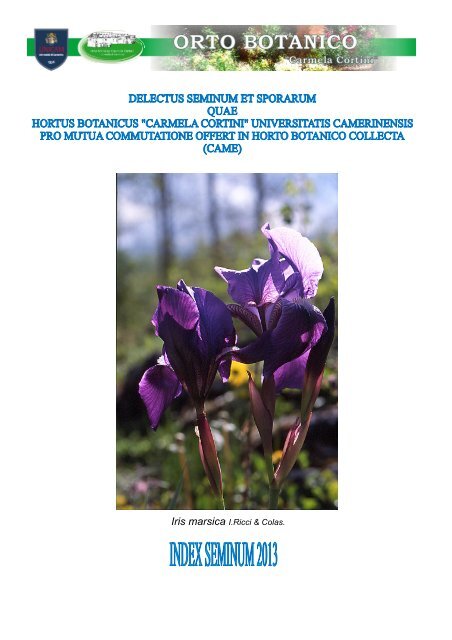

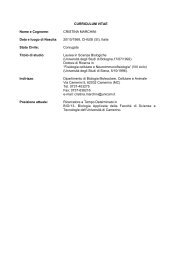
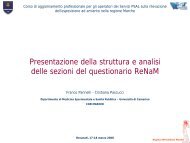
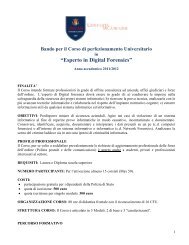
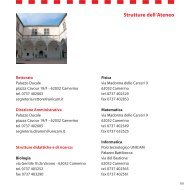
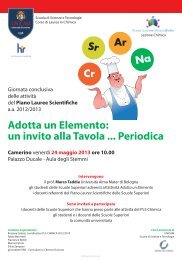
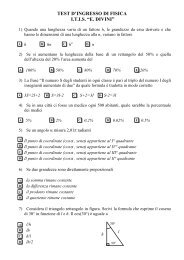
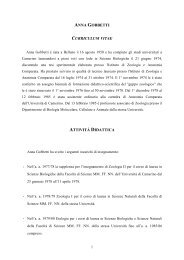
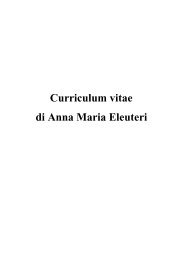
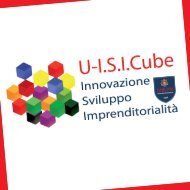
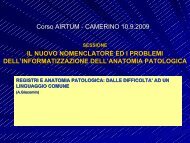
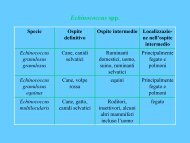
![PROGRAMMA [pdf] - Università degli Studi di Camerino](https://img.yumpu.com/15881781/1/184x260/programma-pdf-universita-degli-studi-di-camerino.jpg?quality=85)
